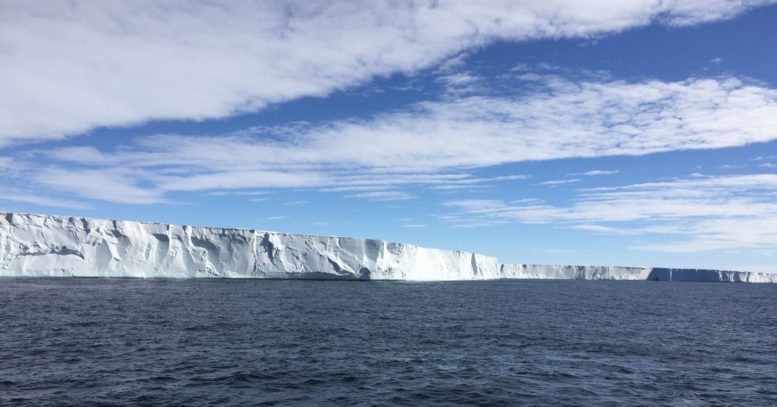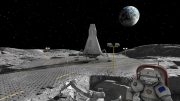
New research highlights how interactions between ocean currents and the ocean floor, rather than just wind, are crucial in driving the rapid melting of Antarctic ice shelves, posing a threat to global sea levels. Dotson Ice Shelf, Amundsen Sea, Antarctica. Credit: Taewook Park
Meandering ocean currents play an important role in the melting of Antarctic ice shelves, threatening a significant rise in sea levels.
A new study published in Nature Communications has revealed that the interplay between meandering ocean currents and the ocean floor induces upwelling velocity, transporting warm water to shallower depths. This mechanism contributes substantially to the melting of ice shelves in the Amundsen Sea of West Antarctica. These ice shelves are destabilizing rapidly and contributing to sea level rise.
Led by Taewook Park and Yoshihiro Nakayama, an international team of researchers from the Korea Polar Research Institute, Hokkaido University, and Seoul National University employed advanced ocean modeling techniques to investigate the underlying forces behind the rapid melting ice shelves. In a departure from prior assumptions linking ice shelf melting primarily to winds over the Southern Ocean, this study underscores the significant role played by the interactions between meandering ocean currents and the ocean floor in driving the melting process.
The Impact on Pine Island and Thwaites Ice Shelves
The Pine Island and Thwaites ice shelves are among the fastest-changing in Antarctica and are of particular interest due to their vulnerability to warming ocean waters. They act as massive barriers restraining the glaciers behind them from flowing into the ocean. However, their rapid melting and potential collapse pose a significant threat to coastal communities worldwide because of the resulting rise in global sea levels.
The study focused on the role of a layer of warm water beneath the frigid surface waters, known as the ‘modified Circumpolar Deep Water,’ in melting these ice shelves from below. “The intensity and trajectory of ocean currents encircling the ice shelves directly govern the influx of warm water, thereby intricately shaping their rate of melting” explains Taewook. This shows the importance of the ocean in understanding and addressing the impacts of climate change.
The researchers paid attention to the ‘thermocline depth’, which is the depth of the interface between warmer deep waters and cooler surface waters. Variations in thermocline depth significantly affect the influx of warm water toward the ice shelves. Until now, it has been believed that intensified westerly winds north of the Amundsen Sea propelled ocean currents along the shelf break, carrying warmer water toward ice shelf cavities. This phenomenon is particularly pronounced during El Niño events.
“Our findings challenge conventional wisdom,” Nakayama asserts. “Our study underscores that the interplay between meandering ocean currents and the ocean floor generates upwelling velocity, bringing warm water to shallower depths. Subsequently, this warm water reaches the ice-ocean interface, accelerating ice shelf melting.” Nakayama concludes, “This internal oceanic process driving ice shelf melting introduces a novel concept. With this in mind, we have to reevaluate winds driving Antarctic ice loss, which can significantly impact future projections.”
Reference: “Amundsen Sea circulation controls bottom upwelling and Antarctic Pine Island and Thwaites ice shelf melting” by Taewook Park, Yoshihiro Nakayama and SungHyun Nam, 11 April 2024, Nature Communications.
DOI: 10.1038/s41467-024-47084-z
The study was funded by the Korea Institute of Marine Science and Technology promotion, the Korea Polar Research Institute, the Ministry of Education, Culture, Sports, Science, and Technology of Japan, and the Inoue Foundation for Science.









Assuming that the situation continues as it is, once the shelf ice melts back to their grounding lines, the wandering currents won’t be able to undercut the remaining ice and there should be an abrupt decrease in the rate of melting.
The so-called buttressing effect of the shelf ice is over-stated. The shelf ice has inherited the momentum of of the glacier upstream, which is mostly determined by the slope and thickness of the glacier, and the friction with the underlying bedrock. If shelf-ice expands during the Winter, the new ice freezing onto the edge of the glacial ice will likewise inherit the velocity of the glacial ice. Any forces that impede the forward motion of the ice should be reflected in pressure ridges in the ice behind the feature that provides an opposing force. That is, if the grounding line provides significant resistance, ice should be piling up behind it. Instead, what is usually observed are tension cracks that mark the boundary where calving takes place.
Citing a model as ‘evidence’ is unconvincing. What is needed to evaluate the models are detailed diagrams of all the important forces that control the glacier movement, along with the equations that support the claims of the net movement. This allows peer reviewers to see the big picture and decide if the model appears reasonable, rather than having to accept the model predictions without an understanding of what assumptions were made in building the model.
Hello spenser good was comment you
st accurate person in the world.The earth does not know me, God, but the time has been set by 6 verses from the Surah of God.I did not set the time of the revelation of the Surahs with the 6 verses of Al-Baqarah.My main duty is to inform astronomers about the collision of the sun with the arm of the galaxy, so that they can find a solution to save humans.Take them to Mars.When meteorites hit the Earth, Mars is the only place where meteorites are less likely to reach the surface of Mars.Does anyone have this true story?time 1:52pm